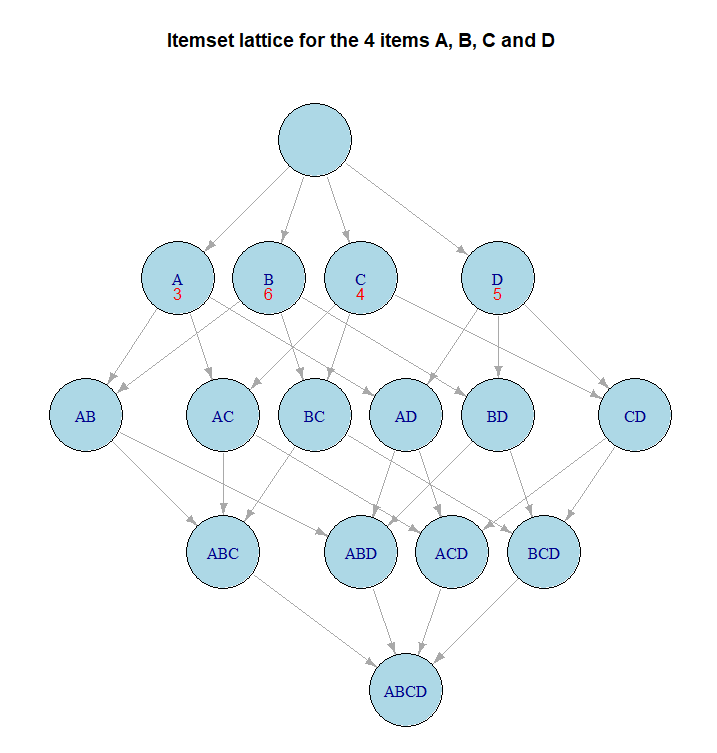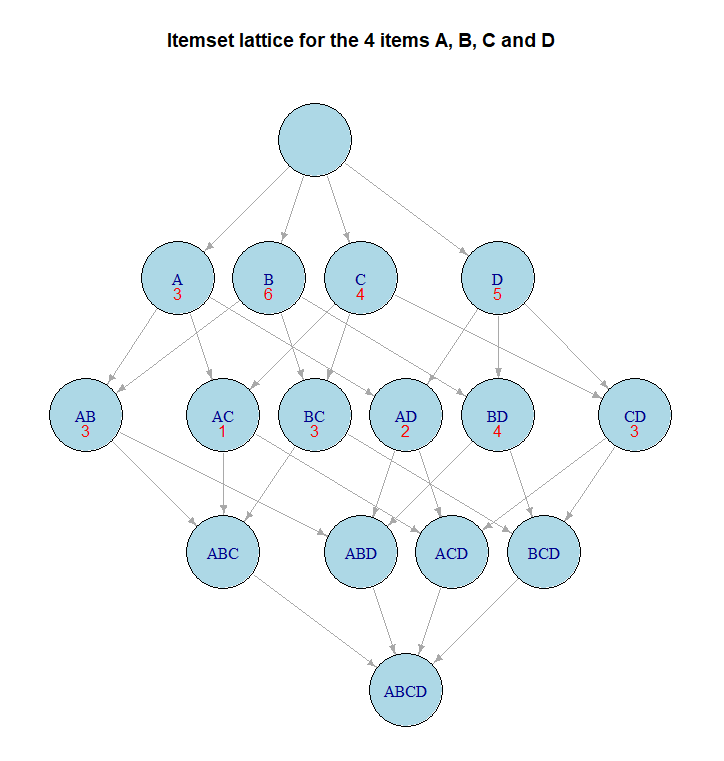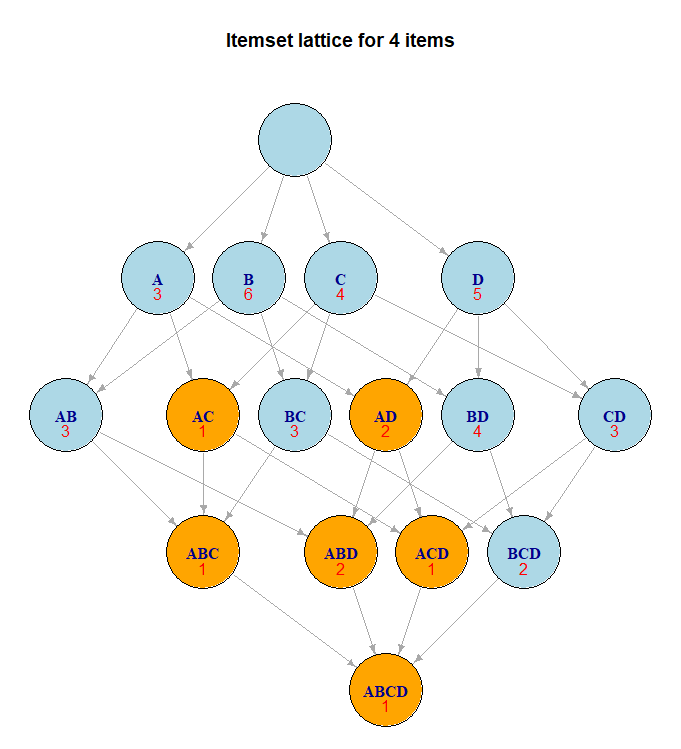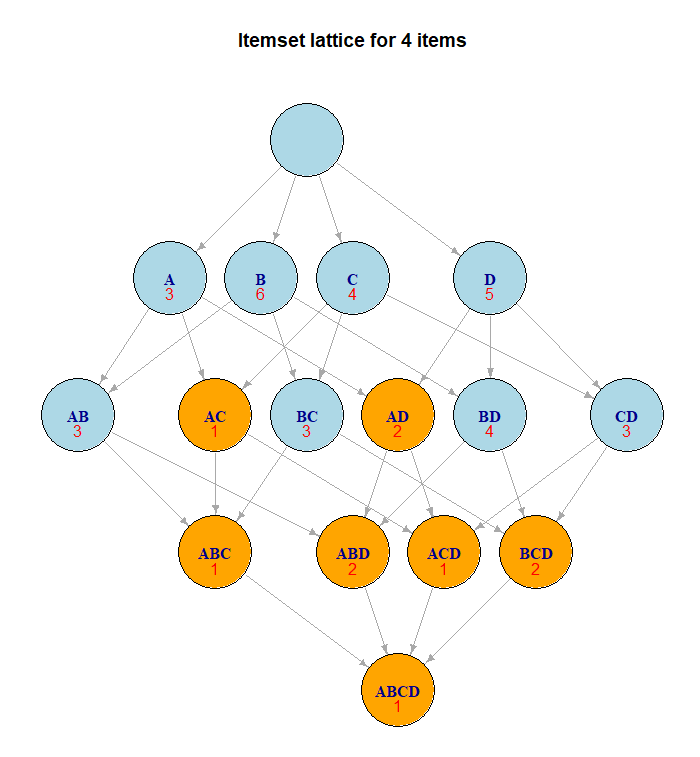The apriori algorithm
Market Basket Analysis in R

Christopher Bruffaerts
Statistician
Association rule mining
Association rule mining allows to discover interesting relationships between items in a large transactional database.
This mining task can be divided into two subtasks:
Frequent itemset generation: determine all frequent itemsets of a potentially large database of transactions. An itemset is said to be frequent if it satisfies a minimum support threshold.
Rule generation: from the above frequent itemsets, generate association rules with confidence above a minimum confidence threshold.
The apriori algorithm is a classic and fast mining algorithm belonging to the class of association rule mining algorithms.
Idea behind the apriori algorithm
The apriori algorithm:
- Bottom-up approach
- Generates candidate itemsets by exploiting the apriori principle
Apriori principle:
- If an itemset is frequent, then all of its subsets must also be frequent.
- e.g. if {A,B} is frequent, then both {A} and {B} are frequent
- For an infrequent itemset, all its super-sets are infrequent.
- e.g. if {A} is infrequent, then {A,B}, {A,C} and {A,B,C} are infrequent.
Example: 1-itemset

| TID | Transaction |
|---|---|
| 1 | {A, B, C, D} |
| 2 | {A, B, D} |
| 3 | {A, B} |
| 4 | {B, C, D} |
| 5 | {B, C} |
| 6 | {C, D} |
| 7 | {B, D} |
Example: 2-itemsets

| TID | Transaction |
|---|---|
| 1 | {A, B, C, D} |
| 2 | {A, B, D} |
| 3 | {A, B} |
| 4 | {B, C, D} |
| 5 | {B, C} |
| 6 | {C, D} |
| 7 | {B, D} |
Example: 3-itemsets

| TID | Transaction |
|---|---|
| 1 | {A, B, C, D} |
| 2 | {A, B, D} |
| 3 | {A, B} |
| 4 | {B, C, D} |
| 5 | {B, C} |
| 6 | {C, D} |
| 7 | {B, D} |
Example: frequent itemsets

| Itemset | Count | Support |
|---|---|---|
| {A} | 3 | 0.42 |
| {B} | 6 | 0.85 |
| {C} | 4 | 0.57 |
| {D} | 5 | 0.71 |
| {A,B} | 3 | 0.42 |
| {B,C} | 3 | 0.42 |
| {B,D} | 4 | 0.57 |
| {C,D} | 3 | 0.42 |
Apriori: rule generation
After the computationally expensive frequent itemset generation, apriori generates rules:
- Start with high-confidence rules with single precedent
- e.g. {A,C} $\rightarrow$ {B}
- Build more complex rules, with more items on the right hand side
- e.g. {A,C} $\rightarrow$ {B, D}
Trick: pruning of association rule
e.g.: if the rule {B,C,D} $\rightarrow$ {A} has low confidence, all rules containing item A in its consequent can be discarded (such as the rule {B,D} $\rightarrow$ {A, C} or {D} $\rightarrow$ {A,B, C}).
A first try with the apriori
Transactional data
inspect(head(trans,2))
items transactionID
[1] {A,B,C,D} 1
[2] {A,B,D} 2
First call to the apriori function - frequent itemsets
support.all = apriori(trans,
parameter = list(supp = 3/7, target="frequent itemsets"))
Output of the apriori - frequent itemsets
Frequent itemsets
inspect(support.all)
items support count
[1] {A} 0.4285714 3
[2] {C} 0.5714286 4
[3] {D} 0.7142857 5
[4] {B} 0.8571429 6
[5] {A,B} 0.4285714 3
[6] {C,D} 0.4285714 3
[7] {B,C} 0.4285714 3
[8] {B,D} 0.5714286 4

Extracting rules with the apriori function
Parameter: the mining parameters change the characteristics of the mined itemsets or rules.
- Support = 3/7
- Confidence = 60%
- Minimum length of rule = 2
Call to the apriori function for rule generation with specific arguments
rules.all = apriori(trans,
parameter = list(supp=3/7, conf=0.6, minlen=2),
control = list(verbose=F)
)
Extracting rules: output
Inspecting the rules
inspect(rules.all)
lhs rhs support confidence lift count
[1] {A} => {B} 0.4285714 1.0000000 1.1666667 3
[2] {C} => {D} 0.4285714 0.7500000 1.0500000 3
[3] {D} => {C} 0.4285714 0.6000000 1.0500000 3
[4] {C} => {B} 0.4285714 0.7500000 0.8750000 3
[5] {D} => {B} 0.5714286 0.8000000 0.9333333 4
[6] {B} => {D} 0.5714286 0.6666667 0.9333333 4
Let's practice!
Market Basket Analysis in R

